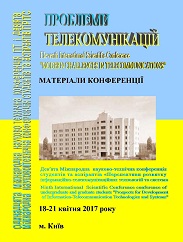МЕТОД СТРОГОЇ ІДЕНТИФІКАЦІЇ АБОНЕНТІВ В ТЕЛЕКОМУНІКАЦІЙНИХ СИСТЕМАХ
Анотація
Method for strong users identification in telecommunication systems
The method for high speed remote users authentication has been proposed. Proposed method realized the zero-knowledge conception of cryptographically strong authentication. Developed method is based on using of standard hash transformation. The procedures for remote users registration and authentication cycle were developed in detail. It has been shown that utilization of proposed technology allowed to increase the identification rate by 2-3 orders.
Посилання
Schneier B. Applied Cryptography. Protocols. Algorithms and Source codes in C. -Ed.John Wiley, 1996 - 758 pp.
Markovskyy O. Fast subscriber identification based on the zero knowledge principle for multimedia content distribution/ O. Markovskyy, N. Bardis, N. Doukas // International Journal of Multimedia Intelligence and Security 2010 - Vol. 1,- pp.78-82.
Feige U. Zero knowledge proofs of identity / Feige U.,Fiat A.,Shamir A.// Journal of Cryptology.- v.1.- №.2.- 1988, pp.77-94.
Pourand G. A realistic security analysis of identification schemes based on combinatorial problems // European Transactions on Telecommunications.- V.8,-№.5.- 1997,- pp.471-480.
##submission.downloads##
Як цитувати
Номер
Розділ
Ліцензія
Авторське право (c) 2017 Олександр Петрович Марковський, Лефтеріос Захаріудакіс, Максим Федорович Федотов

Ця робота ліцензується відповідно до Creative Commons Attribution 4.0 International License.
Authors who submit to this conference agree to the following terms:a) Authors retain copyright over their work, while allowing the conference to place this unpublished work under a Creative Commons Attribution License, which allows others to freely access, use, and share the work, with an acknowledgement of the work's authorship and its initial presentation at this conference.
b) Authors are able to waive the terms of the CC license and enter into separate, additional contractual arrangements for the non-exclusive distribution and subsequent publication of this work (e.g., publish a revised version in a journal, post it to an institutional repository or publish it in a book), with an acknowledgement of its initial presentation at this conference.
c) In addition, authors are encouraged to post and share their work online (e.g., in institutional repositories or on their website) at any point before and after the conference.

